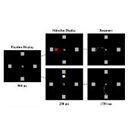Abstract
Competition between conflicting responses enhances cognitive control over responses on the subsequent trial, generating a congruency sequence effect (CSE). The present study investigated the mechanism of post-conflict control involved in the CSE by measuring the spatiotemporal dynamics underlying the Simon task with computer-mouse tracking. To examine control-specific CSEs driven by response conflict, a confound-minimized design was employed, rigorously controlling for stimulus repetitions, response repetitions, contingency learning, and response errors. We presented horizontal and vertical Simon tasks, each with two distinct stimulus and response alternatives, in a trial-to-trial interchanging order. Participants responded by moving a mouse cursor from the screen center to a target response box, determined by stimulus color rather than its location. Dynamic features of spatial precision and movement speed, as well as discrete movement latency and spatial features, were analyzed. Beyond the typical Simon effect, we identified post-conflict slowing and selective suppression of task-irrelevant response activation as two distinguishable modes of post-conflict control that manifest in different movement features and processing stages. This suggests that the CSE likely arises from two sub-processes of post-conflict control, rather than a unitary mechanism.
